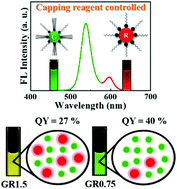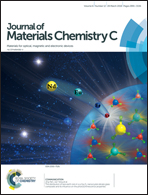Developed one-pot synthesis of dual-color CdSe quantum dots for white light-emitting diode application†
Abstract
Quantum dots (QDs) have attracted tremendous attention due to their outstanding optical properties, which show great potential for next generation lighting and displays. In particular, dual-color QDs (green- and red-emitting) offer significant advantages over the conventional phosphors used in white light-emitting diode (WLED) applications, which are replacing traditional fluorescent lamps due to their improved energy efficiency. However, a facile synthesis of well-controlled dual-color QDs is still one of the major constraints on a wider application of QD-WLEDs. Here, we report a developed one-pot synthesis method to produce dual-color QDs for WLED application. The size and fraction of red and green QDs can be controlled precisely during the synthetic process using HDA and HDA/TOPO as sophisticated capping reagents, respectively, thus manifesting decent optical properties and remarkably enhanced stability. One of our samples, GR0.75 QDs, is demonstrated to produce pure white color in a fabricated WLED device up to 18 hours. Based on advanced characterization, our findings reveal the critical role of the specific capping reagent in the synthesis and structure control of dual-color QDs, while the results regarding the enhanced stability may broaden the avenues for future QD-WLED applications.



 Please wait while we load your content...
Please wait while we load your content...